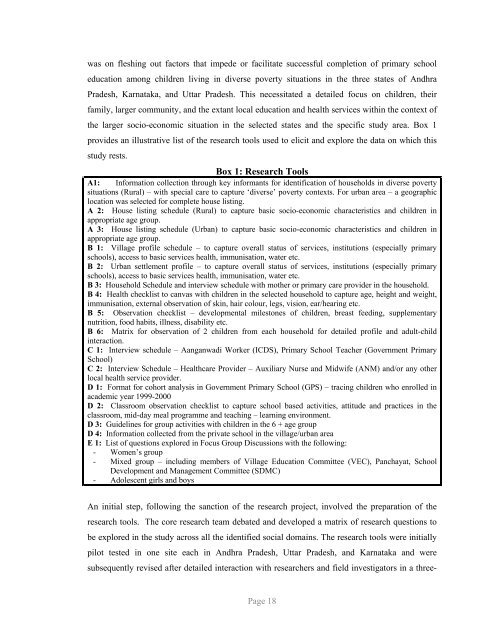Snakes and Ladders - ERU Consultants Pvt. Ltd.
Snakes and Ladders - ERU Consultants Pvt. Ltd.
Snakes and Ladders - ERU Consultants Pvt. Ltd.
You also want an ePaper? Increase the reach of your titles
YUMPU automatically turns print PDFs into web optimized ePapers that Google loves.
was on fleshing out factors that impede or facilitate successful completion of primary school<br />
education among children living in diverse poverty situations in the three states of Andhra<br />
Pradesh, Karnataka, <strong>and</strong> Uttar Pradesh. This necessitated a detailed focus on children, their<br />
family, larger community, <strong>and</strong> the extant local education <strong>and</strong> health services within the context of<br />
the larger socio-economic situation in the selected states <strong>and</strong> the specific study area. Box 1<br />
provides an illustrative list of the research tools used to elicit <strong>and</strong> explore the data on which this<br />
study rests.<br />
Box 1: Research Tools<br />
A1: Information collection through key informants for identification of households in diverse poverty<br />
situations (Rural) – with special care to capture ‘diverse’ poverty contexts. For urban area – a geographic<br />
location was selected for complete house listing.<br />
A 2: House listing schedule (Rural) to capture basic socio-economic characteristics <strong>and</strong> children in<br />
appropriate age group.<br />
A 3: House listing schedule (Urban) to capture basic socio-economic characteristics <strong>and</strong> children in<br />
appropriate age group.<br />
B 1: Village profile schedule – to capture overall status of services, institutions (especially primary<br />
schools), access to basic services health, immunisation, water etc.<br />
B 2: Urban settlement profile – to capture overall status of services, institutions (especially primary<br />
schools), access to basic services health, immunisation, water etc.<br />
B 3: Household Schedule <strong>and</strong> interview schedule with mother or primary care provider in the household.<br />
B 4: Health checklist to canvas with children in the selected household to capture age, height <strong>and</strong> weight,<br />
immunisation, external observation of skin, hair colour, legs, vision, ear/hearing etc.<br />
B 5: Observation checklist – developmental milestones of children, breast feeding, supplementary<br />
nutrition, food habits, illness, disability etc.<br />
B 6: Matrix for observation of 2 children from each household for detailed profile <strong>and</strong> adult-child<br />
interaction.<br />
C 1: Interview schedule – Aanganwadi Worker (ICDS), Primary School Teacher (Government Primary<br />
School)<br />
C 2: Interview Schedule – Healthcare Provider – Auxiliary Nurse <strong>and</strong> Midwife (ANM) <strong>and</strong>/or any other<br />
local health service provider.<br />
D 1: Format for cohort analysis in Government Primary School (GPS) – tracing children who enrolled in<br />
academic year 1999-2000<br />
D 2: Classroom observation checklist to capture school based activities, attitude <strong>and</strong> practices in the<br />
classroom, mid-day meal programme <strong>and</strong> teaching – learning environment.<br />
D 3: Guidelines for group activities with children in the 6 + age group<br />
D 4: Information collected from the private school in the village/urban area<br />
E 1: List of questions explored in Focus Group Discussions with the following:<br />
- Women’s group<br />
- Mixed group – including members of Village Education Committee (VEC), Panchayat, School<br />
Development <strong>and</strong> Management Committee (SDMC)<br />
- Adolescent girls <strong>and</strong> boys<br />
An initial step, following the sanction of the research project, involved the preparation of the<br />
research tools. The core research team debated <strong>and</strong> developed a matrix of research questions to<br />
be explored in the study across all the identified social domains. The research tools were initially<br />
pilot tested in one site each in Andhra Pradesh, Uttar Pradesh, <strong>and</strong> Karnataka <strong>and</strong> were<br />
subsequently revised after detailed interaction with researchers <strong>and</strong> field investigators in a three-<br />
Page 18












